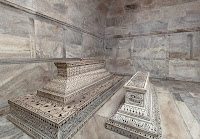The Taj Mahal is a mausoleum located in Agra, India, built by Mughal Emperor Shah Jahan in memory of his favorite wife, Mumtaz Mahal. The Taj Mahal is considered the finest example of Mughal architecture, a style that combines elements from Persian, Indian, and Islamic architectural styles. In 1983, the Taj Mahal became a UNESCO World Heritage Site and was cited as the jewel of Muslim art in India and one of the universally admired masterpieces of worlds heritage.
 While the white domed marble mausoleum is its most familiar component, the Taj Mahal is actually an integrated complex of structures. Building began around 1632 and was completed around 1653, and employed thousands of artisans and craftsmen. The construction of the Taj Mahal was entrusted to a board of architects under imperial supervision including Abdul-Karim Mamur Khan, Makramat Khan, and Ustad Ahmad Lahauri. Lahauri is generally considered to be the principal designer.
While the white domed marble mausoleum is its most familiar component, the Taj Mahal is actually an integrated complex of structures. Building began around 1632 and was completed around 1653, and employed thousands of artisans and craftsmen. The construction of the Taj Mahal was entrusted to a board of architects under imperial supervision including Abdul-Karim Mamur Khan, Makramat Khan, and Ustad Ahmad Lahauri. Lahauri is generally considered to be the principal designer.In 1631, Shah Jahan, emperor during the Mughal empires period of greatest prosperity, was grief stricken when his third wife, Mumtaz Mahal, died during the birth of their fourteenth child, Gauhara Begum. Construction of the Taj Mahal began in 1632, one year after her death. The court chronicles of Shah Jahans grief illustrate the love story traditionally held as an inspiration for Taj Mahal. The principal mausoleum was completed in 1648 and the surrounding buildings and garden were finished five years later. The central focus of the complex is the tomb. This large, white marble structure stands on a square plinth and consists of a symmetrical building with an iwan topped by a large dome and finial. Like most Mughal tombs, the basic elements are Persian in origin.
The base structure is essentially a large, multi-chambered cube with chamfered corners, forming an unequal octagon that is approximately 55 meters on each of the four long sides. Four minarets frame the tomb, one at each corner of the plinth facing the chamfered corners. The main chamber houses the false sarcophagi of Mumtaz Mahal and Shah Jahan; the actual graves are at a lower level. Tall decorative spires extend from edges of base walls, and provide visual emphasis to the height of the dome. The lotus motif is repeated on both the chattris and guldastas. The dome and chattris are topped by a gilded finial, which mixes traditional Persian and Hindu decorative elements.
The main finial was originally made of gold but was replaced by a copy made of gilded bronze in the early 19th century. This feature provides a clear example of integration of traditional Persian and Hindu decorative elements. The finial is topped by a moon, a typical Islamic motif whose horns point heavenward. Because of its placement on the main spire, the horns of the moon and the finial point combine to create a trident shape.


The minarets, which are each more than 40 meters tall, display the designer's penchant for symmetry. They were designed as working minarets a traditional element of mosques, used by the muezzin to call the Islamic faithful to prayer. Each minaret is effectively divided into three equal parts by two working balconies that ring the tower. At the top of the tower is a final balcony surmounted by a chattri that mirrors the design of those on the tomb. The chattris all share the same decorative elements of a lotus design topped by a gilded finial. The minarets were constructed slightly outside of the plinth so that, in the event of collapse, the material from the towers would tend to fall away from the tomb.
The Taj Mahal attracts from 2 to 4 million visitors annually, with more than 200,000 from overseas. Most tourists visit in the cooler months of October, November and February. Polluting traffic is not allowed near the complex and tourists must either walk from parking lots or catch an electric bus. Lists of recommended travel destinations often feature the Taj Mahal, which also appears in several listings of seven wonders of the modern world, including the recently announced New Seven Wonders of the World, a recent poll with 100 million votes.
The grounds are open from 6 am to 7 pm weekdays, except for Friday when the complex is open for prayers at the mosque between 12 pm and 2 pm. The complex is open for night viewing on the day of the full moon and two days before and after, excluding Fridays and the month of Ramzan.
Post Title
→Taj Mahal
Post URL
→http://guidice-galleries.blogspot.com/2010/02/taj-mahal.html
Visit guidice galleries for Daily Updated Wedding Dresses Collection








